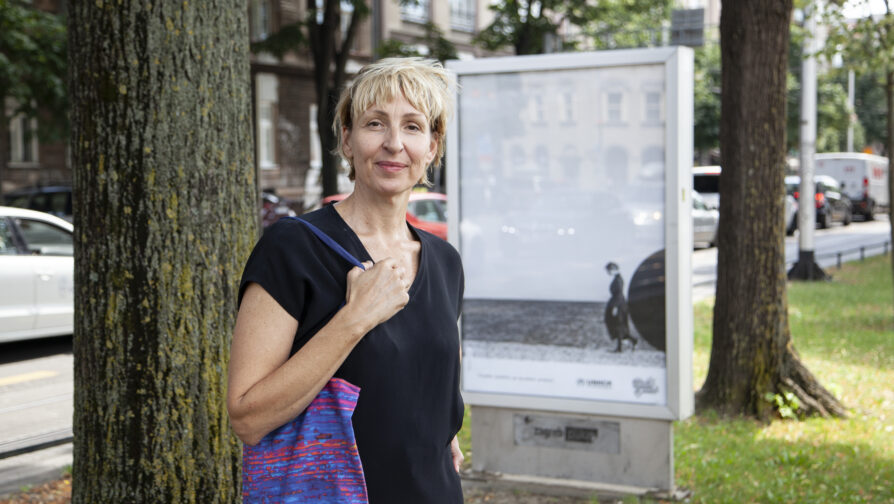Six Croatian artists are taking a new approach to the subject of refugees, turning away from realistic, news-like portraits to more imaginative ways of evoking the experience of being displaced and seeking a home.
Their static and moving images are up on billboards and in public transport across Croatia as part of the 16th annual Festival of Tolerance, in conjunction with World Refugee Day, celebrated by UNHCR since 2001.
“It was our deliberate intention to shift away from a journalistic approach because people are overwhelmed and don’t respond to that anymore,” said exhibition organiser Ivana Meštrov.
“We were looking for more subtle, symbolic images to give a new visual impulse.”
Refugees from Ukraine have been at the top of the news this year but UNHCR’s message for 2022 is that all refugees have the right to seek asylum, “whoever they are, wherever they come from, whenever they are forced to flee”. A record 100,000 million people are now displaced worldwide.
UNHCR and its partner, the Festival, jointly organised the exhibition “Every Person Has the Right to Seek Protection” with the aim of encouraging social dialogue about the rights of refugees and the contribution they can make to host countries.
“With help from welcoming communities, refugees can rebuild their lives and thrive,” said Anna Rich, UNHCR Representative in Croatia. “Refugees bring their cultures, their unique experiences and their hope for a better future – all of which make any community stronger, more vibrant and more inclusive.”
Festival organisers approached a number of local artists specialising in social themes and eventually chose six, whose images are shown large on billboards and posters on public transport in the cities of Dubrovnik, Karlovac, Osijek, Rijeka, Šibenik, Split, Zadar and Zagreb.
“In the 21st century, it is our social responsibility to provide an opportunity to live in peace, in a society that is accepting whenever possible,” said Nataša Popović, director of the Festival. “I believe that in collaboration with local artists and thanks to their amazing works, we shall be able to encourage empathy, understanding and openness in the public.”
Refugees and migrants feature in five out of the 41 films at the Festival, and there will be a public discussion of three of the movies. But it is the billboards and posters on public transport that are likely to reach the widest audience. Two of the artworks will also be shown as short videos on modern trams equipped with digital technology.
Some of these state-of-the-art trams are in the port of Rijeka. Marking World Refugee, the city’s mayor, Marko Filipovic, said: “Rijeka has always been an open city, and today we again proudly stand with refugees.”

Marking World Refugee, the city’s mayor, Marko Filipovic, said: “Rijeka has always been an open city, and today we again proudly stand with refugees.” @UNHCR/Buga Cvjetanović
Rijeka-based artist Milijana Babić, who spent time in South Africa, offers the viewer a deliberately rough sketch of a wanderer with a knapsack to express care for all travellers. Split-based Neli Ružić, drawing on her time in Mexico, arranges stones and string to suggest the attempt of a displaced person to find a personal space, however fragile, and mark it.
Luka Duplačić, a member of an ecological art collective in Split, presents a delicately drawn human face merging into nature. “It’s a universal image, showing a state of reflection, even melancholy,” commented Ivana Meštrov, the exhibition organiser.
In one of the videos, Tonka Maleković accompanies an image of a spinning globe with poetry about being on the move: “I met people without clear boundaries, such people as I had not known before and as I have myself become…”
In a collage of refugee figures adrift on a raft, Mexican-born Croatian resident Eric del Castilla alludes to the famous painting “The Raft of Medusa” by 18th-19th century French painter Théodore Géricault. “In Eric’s picture, a little girl is gazing out, pointing to us,” said Ivana. “It’s a strong image of survival.”
Renata Poljak, a well-known artist from Zagreb, contributes an image of a woman in a long black dress on a beach – part of a series of collages called Partenza (Italian for Departure).
She said she was touched by the plight of Africans trying to cross to Italy for whom “the Mediterranean became a graveyard”.
“But I didn’t want to take a documentary approach. That’s what journalists do.”
Instead, she delved into her own family history to tell the story of her great grandfather, who left Croatia because of hunger on the islands and went to work as a farm labourer in Chile. Her great-grandmother waited in hope for him in Croatia, but he died in faraway Patagonia.
“I wanted to show that we are all in the same boat,” Renata said, referring to the poor of the past and the refugees of today. “Perhaps this more poetic treatment of the subject will make people think.”

Renata Poljak, a well-known artist from Zagreb, contributes an image of a woman in a long black dress on a beach – part of a series of collages called Partenza (Italian for Departure) @UNHCR/Buga Cvjetanović
Most refugees in Croatia have yet to see the exhibition, but Samaneh, 41, from Iran did get a look before the launch. Standing next to Eric’s collage of refugees on a raft, she said: “It is as sad as our lives on the way to Europe. Physical pain vanishes, but emotional pain is always with the refugees. The refugees didn’t just get wet in the rain, they felt the rain.”
Podijeli na Facebook-u Podijeli na Twitteru